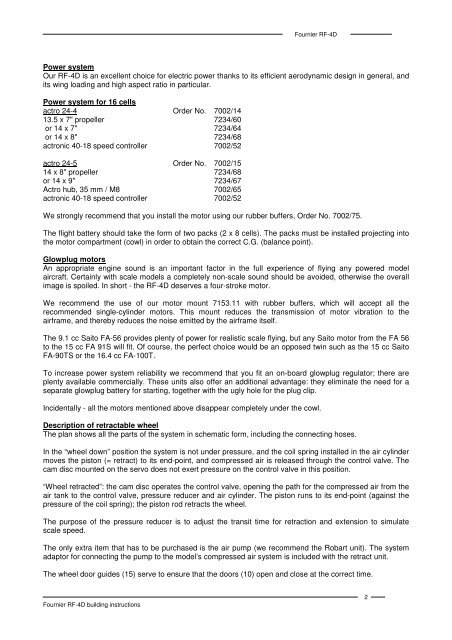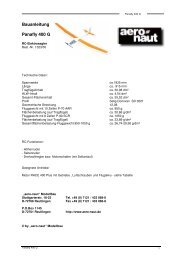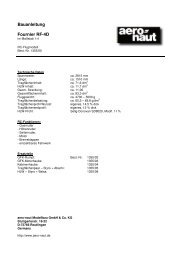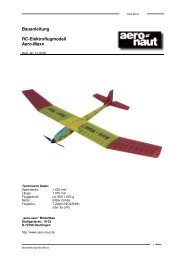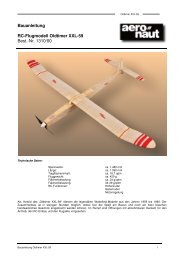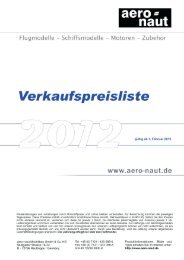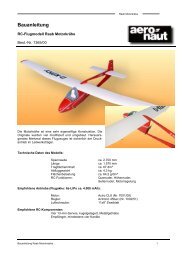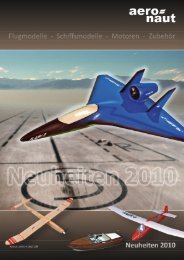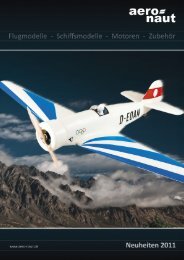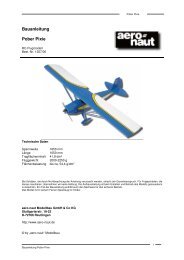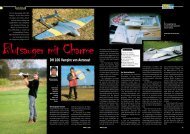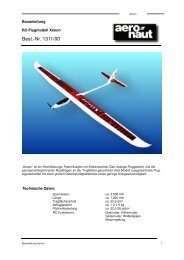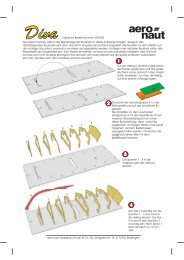Building instructions Fournier RF-4D - Aero-naut
Building instructions Fournier RF-4D - Aero-naut
Building instructions Fournier RF-4D - Aero-naut
You also want an ePaper? Increase the reach of your titles
YUMPU automatically turns print PDFs into web optimized ePapers that Google loves.
<strong>Fournier</strong> <strong>RF</strong>-<strong>4D</strong> building <strong>instructions</strong><br />
<strong>Fournier</strong> <strong>RF</strong>-<strong>4D</strong><br />
Power system<br />
Our <strong>RF</strong>-<strong>4D</strong> is an excellent choice for electric power thanks to its efficient aerodynamic design in general, and<br />
its wing loading and high aspect ratio in particular.<br />
Power system for 16 cells<br />
actro 24-4 Order No. 7002/14<br />
13.5 x 7" propeller 7234/60<br />
or 14 x 7" 7234/64<br />
or 14 x 8" 7234/68<br />
actronic 40-18 speed controller 7002/52<br />
actro 24-5 Order No. 7002/15<br />
14 x 8" propeller 7234/68<br />
or 14 x 9" 7234/67<br />
Actro hub, 35 mm / M8 7002/65<br />
actronic 40-18 speed controller 7002/52<br />
We strongly recommend that you install the motor using our rubber buffers, Order No. 7002/75.<br />
The flight battery should take the form of two packs (2 x 8 cells). The packs must be installed projecting into<br />
the motor compartment (cowl) in order to obtain the correct C.G. (balance point).<br />
Glowplug motors<br />
An appropriate engine sound is an important factor in the full experience of flying any powered model<br />
aircraft. Certainly with scale models a completely non-scale sound should be avoided, otherwise the overall<br />
image is spoiled. In short - the <strong>RF</strong>-<strong>4D</strong> deserves a four-stroke motor.<br />
We recommend the use of our motor mount 7153.11 with rubber buffers, which will accept all the<br />
recommended single-cylinder motors. This mount reduces the transmission of motor vibration to the<br />
airframe, and thereby reduces the noise emitted by the airframe itself.<br />
The 9.1 cc Saito FA-56 provides plenty of power for realistic scale flying, but any Saito motor from the FA 56<br />
to the 15 cc FA 91S will fit. Of course, the perfect choice would be an opposed twin such as the 15 cc Saito<br />
FA-90TS or the 16.4 cc FA-100T.<br />
To increase power system reliability we recommend that you fit an on-board glowplug regulator; there are<br />
plenty available commercially. These units also offer an additional advantage: they eliminate the need for a<br />
separate glowplug battery for starting, together with the ugly hole for the plug clip.<br />
Incidentally - all the motors mentioned above disappear completely under the cowl.<br />
Description of retractable wheel<br />
The plan shows all the parts of the system in schematic form, including the connecting hoses.<br />
In the “wheel down” position the system is not under pressure, and the coil spring installed in the air cylinder<br />
moves the piston (= retract) to its end-point, and compressed air is released through the control valve. The<br />
cam disc mounted on the servo does not exert pressure on the control valve in this position.<br />
“Wheel retracted”: the cam disc operates the control valve, opening the path for the compressed air from the<br />
air tank to the control valve, pressure reducer and air cylinder. The piston runs to its end-point (against the<br />
pressure of the coil spring); the piston rod retracts the wheel.<br />
The purpose of the pressure reducer is to adjust the transit time for retraction and extension to simulate<br />
scale speed.<br />
The only extra item that has to be purchased is the air pump (we recommend the Robart unit). The system<br />
adaptor for connecting the pump to the model’s compressed air system is included with the retract unit.<br />
The wheel door guides (15) serve to ensure that the doors (10) open and close at the correct time.<br />
2


